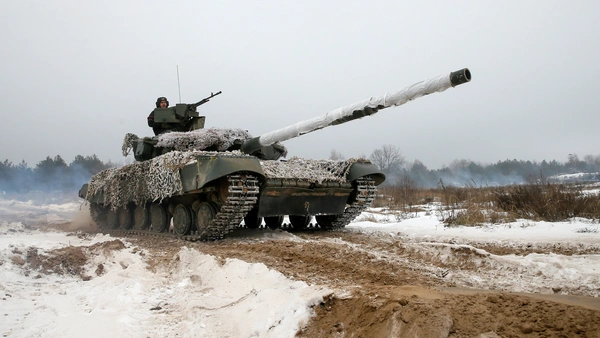by Thomas Graham
 One of the highest rated concerns in this year’s Preventive Priorities Survey was the outbreak of a severe crisis between Russia and Ukraine following increased fighting in eastern Ukraine, and/or a major military clash in contested areas. In contrast to the results of the survey, I would argue that the likelihood of such a crisis is actually low. For the past several months, Russia and Ukraine have pursued confidence-building measures, such as prisoner exchanges and separation of forces in eastern Ukraine (the Donbas), to reduce the risk of serious conflict. Moscow has little interest in escalating the fighting: instead, it is focused on persuading the European Union to ease sanctions that have been dragging its economy. Kyiv has little capacity for a sustained military effort and worries about whether Europe would have its back, especially as French President Emmanuel Macron appears intent on pursuing détente with Russia. The Donbas separatists themselves have little room for maneuver, absent strong backing from Moscow.
One of the highest rated concerns in this year’s Preventive Priorities Survey was the outbreak of a severe crisis between Russia and Ukraine following increased fighting in eastern Ukraine, and/or a major military clash in contested areas. In contrast to the results of the survey, I would argue that the likelihood of such a crisis is actually low. For the past several months, Russia and Ukraine have pursued confidence-building measures, such as prisoner exchanges and separation of forces in eastern Ukraine (the Donbas), to reduce the risk of serious conflict. Moscow has little interest in escalating the fighting: instead, it is focused on persuading the European Union to ease sanctions that have been dragging its economy. Kyiv has little capacity for a sustained military effort and worries about whether Europe would have its back, especially as French President Emmanuel Macron appears intent on pursuing détente with Russia. The Donbas separatists themselves have little room for maneuver, absent strong backing from Moscow.
The low likelihood of a crisis, however, does not mean that the Russian-Ukrainian dispute is close to resolution. Russian leaders have yet to be reconciled to Ukraine’s independence. Russia’s security and prosperity, they believe, require that Ukraine be tightly bound to Russia. Ukraine, however, has resisted Russia’s embrace, seeking to reinforce its independence through closer ties to Europe and the United States. In 2014, Russia annexed Crimea and fomented rebellion in the Donbas to forestall what it feared was Ukraine’s rapid movement away from Russia toward Europe after a pro-Western popular uprising ousted the Russian-backed president. The intensity of the conflict in the Donbas, which has taken more than 13,000 lives, has subsided considerably since 2014-15, but fighting continues along the line of contact separating the belligerents. Moscow denies Western accusations that its forces have participated directly in the fighting. The Normandy Format—France, Germany, Russia, and Ukraine—was created in 2014 with the aim of resolving the conflict.
Ukraine’s new president, Volodymyr Zelensky, won a landslide victory in spring 2019 with a pledge to end the Donbas conflict. Some progress has been made in easing tension, but the parties remain far apart on the core issue—the nature of the special status to be accorded the rebellious regions inside Ukraine as stipulated in the Minsk Agreement, the agreed framework for resolving the conflict. Kyiv wants to give the regions as little autonomy as possible so as to preserve the integrity of the Ukrainian state, while Moscow seeks substantial rights that would amplify its leverage over Kyiv. A meeting of the Normandy Format in December 2019 failed to make progress on this matter. Meanwhile, the Donbas remains volatile, according to the Organization for Security and Cooperation in Europe (OSCE) Special Monitoring Mission to Ukraine, which reports frequent ceasefire violations.
The United States supports Ukraine’s sovereignty and territorial integrity. It has denounced Russia’s actions in Crimea and the Donbas as flagrant violations of international norms and threats to European security. To punish and deter Russia, it has levied wide-ranging sanctions, provided military and other assistance to Ukraine, and worked with the North Atlantic Treaty Organization (NATO) to bolster its capability to meet any future Russian challenge. To help resolve the conflict, the United States, in conjunction with its European allies, needs to support Ukraine while pressing it to enact the reforms needed to grow its economy and state capacity. Washington also needs to step up diplomatic engagement with Moscow to make some tough compromises that satisfy Russia’s minimal security needs while strengthening Ukraine’s statehood.
About the Preventive Priorities Survey
Since 2008, the Council on Foreign Relations’ Center for Preventive Action (CPA) has conducted an annual survey of foreign policy experts for their collective assessments on contingencies that represent the greatest risk to U.S. interests. This year, CPA began soliciting contingencies in October 2019, narrowing down a list of possible conflicts from nearly one thousand suggestions to thirty contingencies deemed likely and potentially harmful to U.S. interests. In early November, CPA sent the survey to nearly six thousand experts and received about five hundred responses. The survey results were scored according to their rankings and the contingencies were sorted into one of three preventive priority tiers (I, II, III) according to their placement on CPA’s risk assessment matrix.
The results reflect the expert opinion of respondents at that time. As such, it should be viewed as a snapshot assessment. Recognizing this, CPA tracks ongoing conflicts with the Global Conflict Tracker.
No comments:
Post a Comment